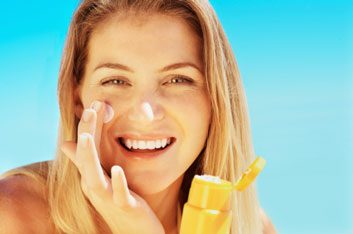
1. You don’t reapply
Every morning you diligently apply SPF and pack a bottle of sunscreen when you know you’re going to be out all day, but chances are you’re not reapplying as frequently as you should. “People think that buying a high SPF will allow them to put it on once and leave it on, but that’s not true,” explains Anastasia Ivanova, Campaign Manager for La Roche-Posay’s MySkinCheck. “Regardless of the SPF, you need to reapply every two hours.” Dr. Sandy Skotnicki, Medical Director of the Bay Dermatology Centre agrees, “You need to reapply every two hours as the chemical sunscreens break down in the sun.”
For casual exposures, say running a couple errands outside or going to work, newer technologies in sunscreens such as Neutrogena, La Roche-Posay and Ombrelle, will last eight hours, assuming you aren’t jumping in the water or excessively sweating. “A good habit to get into is to apply a bit of sunscreen to the arms, chest and face before you dress in the morning,” says Dr. Skotnicki. “I would not worry about reapplying in these cases, unless you’re high risk, which means, fair skin, freckles, over 50 moles or a family history of skin cancer.”
Swimming or sweating up a storm? Even if you’re using a sunscreen that has a “water-resistant” or “sweat-proof” label, you need to reapply shortly after. “Water-resistant means it retains its SPF 45 minutes after bathing,” says Ivanova. “You won’t lose it right when you go in the water, but after that it will deteriorate, so you need to reapply.”
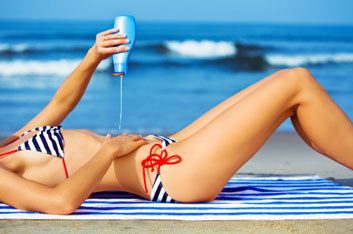
2. You don’t use enough sunscreen
“A lot of people have leftover sunscreen bottles from last season and if you apply properly that can never happen,” says Ivanova. The amount required to adequately cover your entire body is about the size of an egg, a golf ball or shot glass. “People put it on and they spread it, so that it’s not white,” explains Ivanova. “You can be white at the beginning, but it will absorb. That’s what gives you the maximum protection.”
Dr. Romy Saibil, Co-Medical Director at the True MediSpa in Toronto, agrees that it’s better to err on the side of a liberal application, “You can’t be too stingy on your sunblock. More is better.” And it’s still important to apply 20-30 minutes prior to heading outside, as your skin needs to absorb the chemical blocks in the sunscreen.
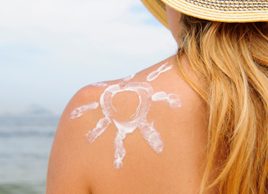
3. You aren’t using the right SPF
Many people think that if they choose a high SPF, like a 60 or above, they’ll be protected for hours. Unfortunately that’s not the case. “Some very high SPF sunscreens can have little to no UVA protection,” admits Dr. Skotnicki. “The SPF only tells you UVB protection, so look on the bottle for broad spectrum coverage.”
Currently in Canada, the only indication for sunscreen is SPF, which stands for Sun Protection Factor, although regulations are in the midst of changing. SPF only protects against UVB rays, the kind associated with sunburns, while UVA rays penetrate deeper into the skin and contribute to skin aging and skin cancer. While you may not burn as quickly with a higher SPF, if the sunscreen doesn’t contain UVA protection, you’re putting yourself at risk.
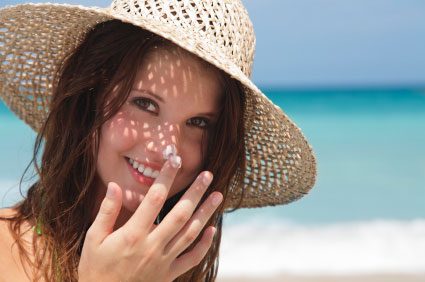
4. You’re forgetting areas
You’ve slathered sunscreen on your face and have a pair of shades on, but did you remember your ears, lips or even your scalp? Men especially need to consider their ears, the back of the neck and their scalp. “A baseball cap is good for the scalp and heat stroke, but the bill in the front only shades your forehead and nose,” says Dr. Francine Gerstein, Co-Medical Director at True MediSpa who recommends liberally applying sunscreen on exposed areas.
For women with long hair a wide-brimmed hat is ideal. “A hat with a 4-inch brim to cover the back of the neck and ears is the best,” suggests Dr. Skotnicki who says that studies have been done to determine that this is the best size when it comes to sun protection. Since you can’t put the same sunscreen you use on your face on your lips, look for a broad-spectrum lip protection, not just one containing SPF. One of Dr. Skotnicki’s favourite lip products is the Anthelios XL SPF 50+ Lip Stick by La Roche-Posay, which has UVA and UVB protection.
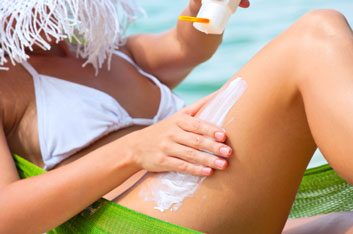
5. You’re using expired sunscreen
Although you shouldn’t have leftover sunscreen from the previous year, if you do, throw it out. “Sunscreen is good for six months,” says Ivanova. “People always have left over sunscreen from a few years ago and the filters in there aren’t good anymore.” There may be some instances where an expired product won’t do you any harm, but this isn’t one of those cases. Be sun safe and get yourself a new bottle (or two).
Related:
• 10 sunburn-soothing tips
• Is it safe to get a base tan?
• 6 healthy tanning alternatives
